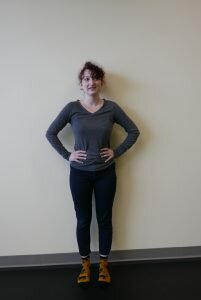The young children walking beside me through the tiny village in Kenya carried small loads on their heads. They were practicing to be like their moms, who effortlessly carried 40-pound buckets of well water on their heads every day, singing, smiling and gossiping along the way. They cajoled me into balancing a water bottle on my head. I laughed, enjoying the balance and challenge involved, as the bottle fell off my head.
To carry the bottle correctly, I couldn’t scrunch my neck or compress my lower back. Instead, my head reached up to the water bottle, creating length in my spine. The heavier the item, the more the women have to contract their abdominal oblique muscles (the abdominal muscles that run at angles along your waist) and intrinsic back muscles (the inner corset). As they contract their inner corsets, their torsos become narrower and taller, lengthening their spines to counteract the weight.
While I definitely don’t walk miles to get water and wood every day, I learned some amazing body mechanics from watching the Kenyan women. Rather than crumpling under the force of gravity and 40 pounds of water, they reached up tall. The best skiers and snowboarders also have these strong inner corset muscles. They stand long and strong, flexing their ankles and bending their knees rather than bending at their waist or rounding their backs.
 Engaging Your Inner Corset
Engaging Your Inner Corset
Before you start these exercises, put your hands on your waist across from your belly button (1). Gently exhale and bring your belly towards your spine. Feel how your abdominal muscles contract just slightly? You have just engaged your inner corset.

Now stand against a smooth door or wall with your heels about one to two inches away from the wall and just feel the back of your body (2). Do you notice both shoulders against the wall? Is one shoulder more forward than the other? How far does your back arch from the wall? Is your head against the wall or is it forward? Without straining, move your head back against the wall. Is your jaw relaxed? How does your neck feel? If your upper back is severely rounded this movement will be difficult for you but if you keep practicing this every day, your body will change.
 Place your hands on your waist again and exhale, gently drawing your belly toward your spine. Now, as you inhale, flex or bend your ankles and bend your knees slowly, keeping your back against the wall, drawing your belly into your spine (3). Place a hand on your lower back and just breathe. If you tend to arch your lower back a great deal, then gently press the arch towards the wall. This will help stretch your lower back muscles so that your inner corset can contract a little more. Do you feel how your back slides down the wall as you bend your knees? Notice the arch of your back against the wall and feel how your back has lengthened.
Place your hands on your waist again and exhale, gently drawing your belly toward your spine. Now, as you inhale, flex or bend your ankles and bend your knees slowly, keeping your back against the wall, drawing your belly into your spine (3). Place a hand on your lower back and just breathe. If you tend to arch your lower back a great deal, then gently press the arch towards the wall. This will help stretch your lower back muscles so that your inner corset can contract a little more. Do you feel how your back slides down the wall as you bend your knees? Notice the arch of your back against the wall and feel how your back has lengthened.
 Now as you exhale, keeping your inner corset engaged, slide back up the wall (4). At the very top, make sure that you straighten your legs all the way – feel how your abdominal muscles are engaged. This is your inner corset working. Make sure your neck, jaw and the muscles around your eyes are relaxed. Return your hand to your lower back. If you normally have a great deal of arch, notice if it is less. Do this exercise at least 10 times a day, building up to a minute each time to tone your inner corset and strengthen your legs for ski season. Stop if it hurts your back.
Now as you exhale, keeping your inner corset engaged, slide back up the wall (4). At the very top, make sure that you straighten your legs all the way – feel how your abdominal muscles are engaged. This is your inner corset working. Make sure your neck, jaw and the muscles around your eyes are relaxed. Return your hand to your lower back. If you normally have a great deal of arch, notice if it is less. Do this exercise at least 10 times a day, building up to a minute each time to tone your inner corset and strengthen your legs for ski season. Stop if it hurts your back.
The Kenyan countrywomen and children move with an inherent grace and strength that I envy. Their lives depend on moving well. If they don’t move well they can’t walk for miles to get their water and they can’t plant their fields. By engaging your inner corset muscles gently you too can create healthy length for your back, and strengthen and lengthen your abdominal muscles. Having a strong inner corset allows you to ski and snowboard for longer and with more agility and balance in all conditions.